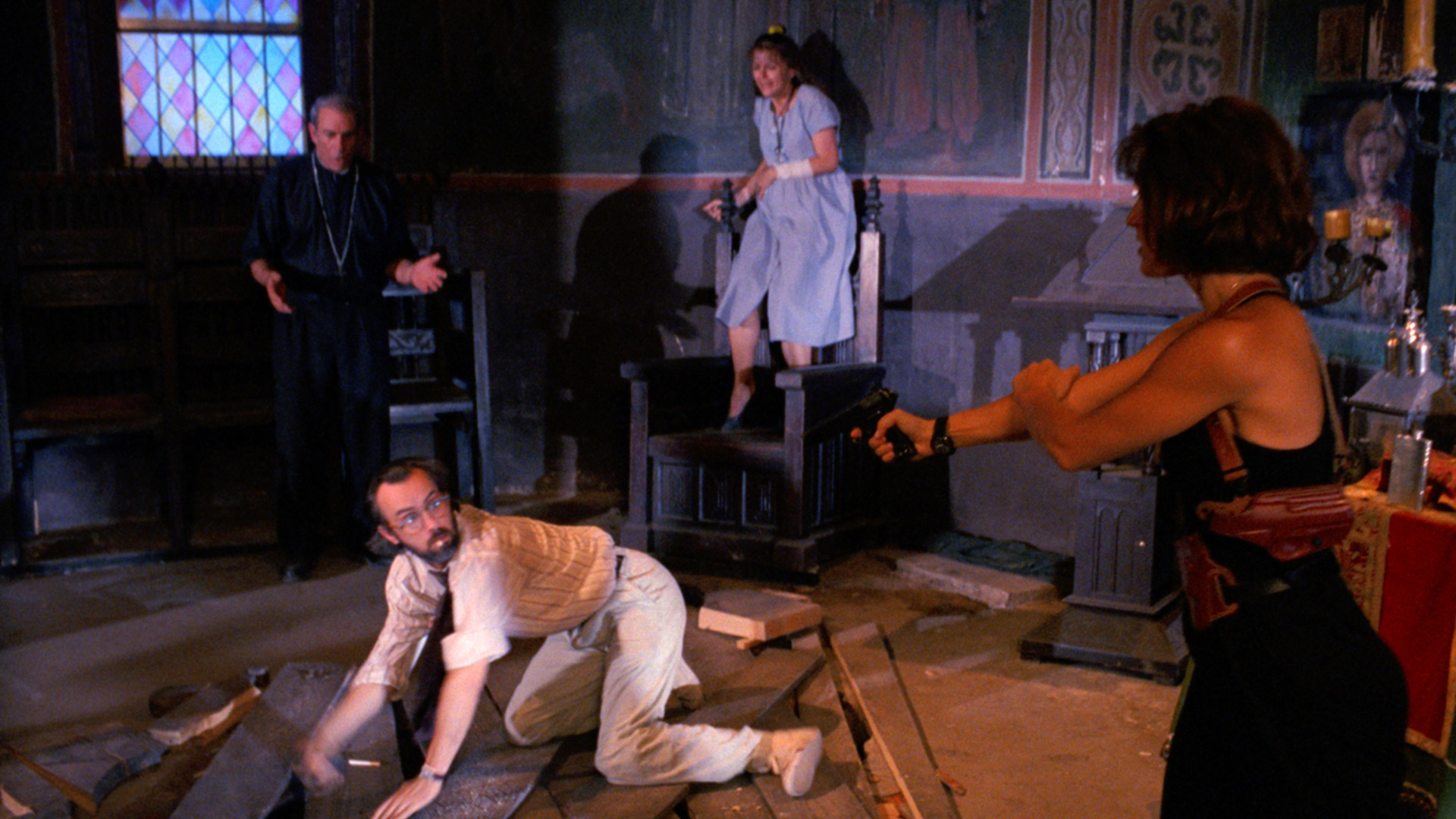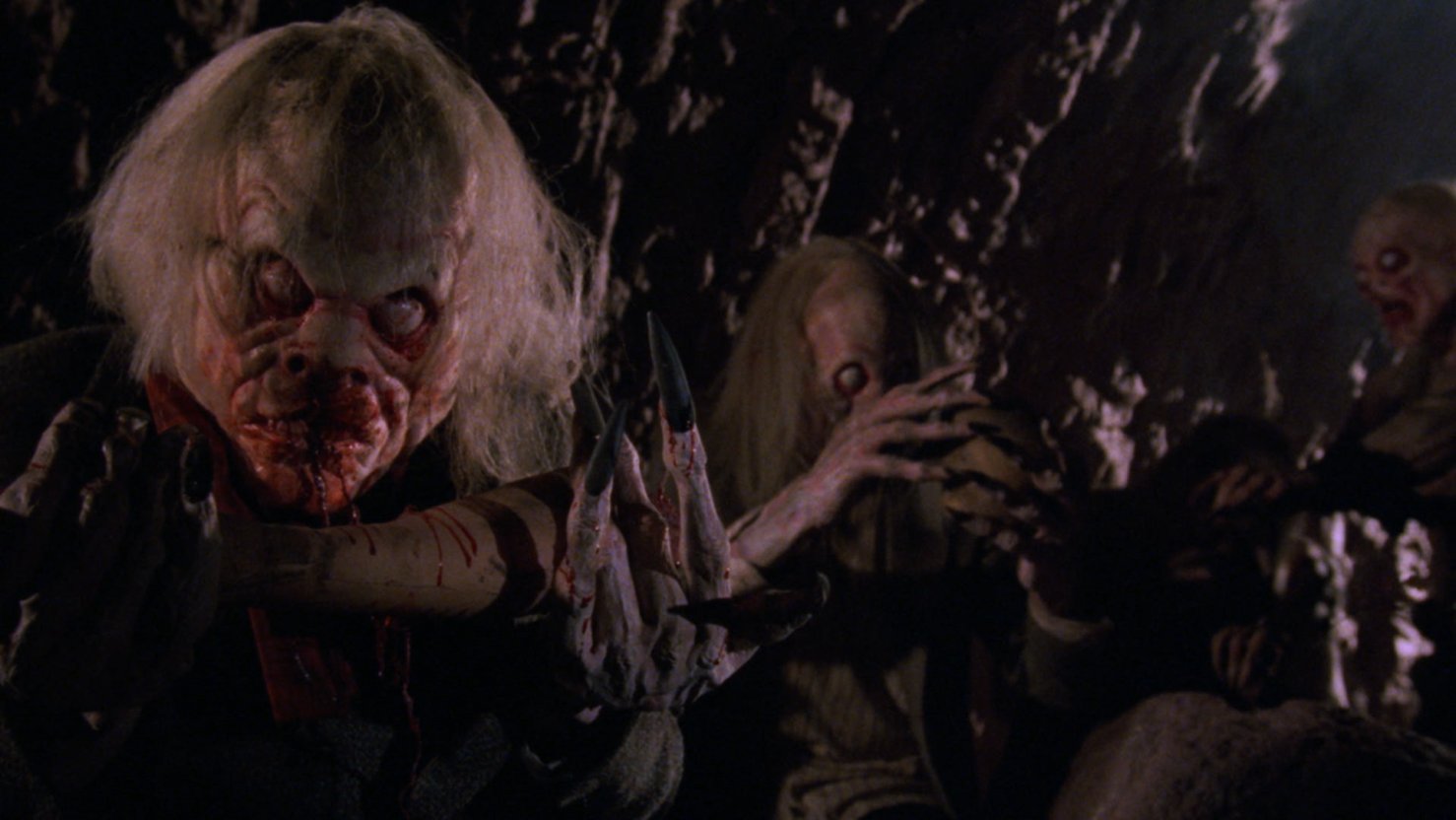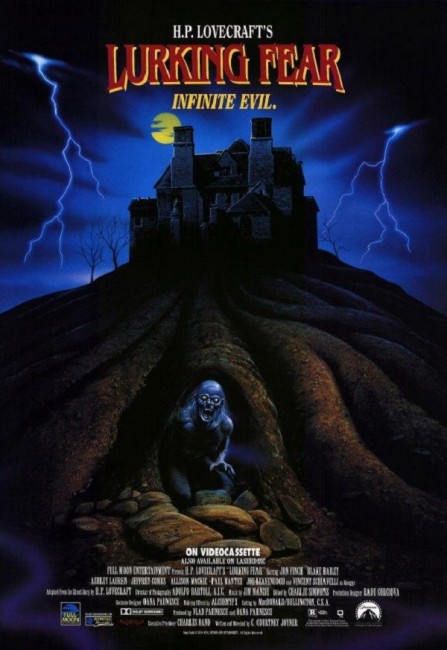USA. 1994.
Crew
Director/Screenplay – C. Courtney Joyner, Based on the Short Story The Lurking Fear by H.P. Lovecraft, Producers – Oana Paunescu & Vlad Paunescu, Photography – Adolfo Bartoli, Music – Jim Manzie, Makeup Effects – AlchemyFX (Supervisor – Michael S. Deak), Production Design – Milo. Production Company – Full Moon Entertainment.
Cast
Blake Bailey (John Martense), Jon Finch (Bennett), Ashley Lauren [Laurence] (Cathryn Farrell), Jeffrey Combs (Dr Haggis), Allison Mackie (Ms Marlowe), Paul Mantee (Father Poole), Vincent Schiavelli (Skelton Knaggs), Joe Leavengood (Pierce), Cristina Stoica (Maria)
Plot
John Martense is released after a five-year jail sentence for a crime he insists he did not commit. The undertaker Knaggs persuades him that the Martense family fortune lies buried in the graveyard in Lefferts Corners. John returns to Lefferts Corners to search for the money just as a group of locals barricade themselves in the church determined once and for all to destroy the things that lurk beneath the graveyard. At the same time, the British gangster Bennett and two of his thugs arrive, bent on taking the money. In the midst of the tense standoff, the creatures beneath the graveyard begin to stir.
Father and son producers Albert and Charles Band had one of their biggest hits with Stuart Gordon’s Re-Animator (1985). This was adapted from a series of stories by horror writer H.P. Lovecraft. The success of this sparked off a series of Lovecraft adaptations in the late 1980s/early 90s, which included The Curse (1987), The Unnameable (1988), The Resurrected (1992) and Necronomicon (1993). The Bands and Stuart Gordon went onto make one other Lovecraft adaptation with From Beyond (1986). Gordon for a time tried to launch a version of The Shadow Over Innsmouth (1936) under the Bands, although this failed to come off, and he later went onto make Dagon (2001) elsewhere, while Re-Animator producer Brian Yuzna made Bride of Re-Animator (1990) and the Lovecraft anthology Necronomicon. (For a list of other H.P. Lovecraft adaptations see bottom of the page or Lovecraftian Films).
The Lurking Fear (1923) was a story that H.P. Lovecraft published in Home Brew magazine serialised over four issues. In the story, the monster-hunting narrator and others take refuge in the abandoned Martense mansion in The Catskills during a storm, only to find it filled with lurking creatures. Following the creatures into their underground lair that stretches beneath the graveyard, the concluding twist of the story is the revelation that the creatures are the degenerated remains of the Martense family. The story has previously formed the basis of the low-budget Dark Heritage (1989) and subsequently the Dan O’Bannon scripted Hemoglobin/Bleeders (1997), although neither film credits Lovecraft as the source, and The Lurking Fear (2023).

C. Courtney Joyner has been a regular screenwriter in low-budget genre cinema with scripts for films such as From a Whisper to a Scream (1986), Class of 1999 (1990), Veronica 2030 (1999), Nautilus (2000), Devil’s Prey (2001), Instinct to Kill (2001), Deadly Stingers (2003), several thrillers for Mark L. Lester and much work for the Bands with Prison (1987), Puppetmaster III: Toulon’s Revenge (1991), Doctor Mordrid (1992), Trancers 6 (2002) and Puppet Master vs Demonic Toys (2004). Joyner made his directorial debut previously with the Bands’ Trancers III (1992). Lurking Fear was his second directorial outing but due to purported difficulties on set, it has been his final time in the director’s chair to date.
The Bands were clearly hoping that Lurking Fear would be another Re-Animator. The film has a good opening scene with two sisters fending off creatures reaching through the wall and trying to snatch the baby crib with a wire hangar, before grabbing and bloodily dragging one of the sisters through a small grate. The scene seems promising for what is to come – only the great crime is that Lurking Fear then slows down.
Fully two-thirds of the rest of the film concerns itself with bringing the various characters together in a church but then it just leaves them there arguing about the situation, while occasionally a claw sticks up through the floorboards. The script doesn’t do enough to play either the tensions between the party off against each other or mount the siege situation to anything particularly intensive. It feels more like half-an-hour plus of the film’s running time sitting around a cheap set waiting for something to happen. Certainly, if the Bands were hoping that Lurking Fear was going to be another Re-Animator or even a From Beyond, what we have feels like the antithesis of that – something where Stuart Gordon’s splatter, outrages and black humour is almost entirely absent.

Nor for that matter is there much of H.P. Lovecraft to the film. Mindedly, the Bands and Stuart Gordon’s take on Lovecraft tossed much of his psychological mood and unspeakable horrors out the window in favour of gore and creature effects, which is almost the antithesis of a Lovecraftian story. Lurking Fear does perhaps come closer to Lovecraft than Re-Animator, which was a less typical Lovecraftian story. The Martense mansion has been replaced by a church, which one supposes is an acceptable trade-off that is less costly on large sets. On the other hand, none of the characters in the film have any semblance in the story, while the family treasure angle has been invented to drive proceedings along. Only in the last fifteen minutes of the film do the creatures lurking below get unleashed – some tolerably cheap makeup effects – and we get the full explanation of what they are and their ties to Martense lineage, which is where the Lovecraft story eventually arrived at.
The film does have some interesting casting. Top-lined is Jon Finch, a British stage actor who was a minor rising name in the 1970s, in particular in genre efforts such as the Alfred Hitchcock psycho-thriller Frenzy (1972) and the Michael Moorcock adaptation The Final Programme (1974). There is also Ashley Laurence, the heroine from Hellraiser (1987), for some reason billed here as Ashley Lauren (maybe she was hiding or someone writing up the credits made a typo), who has what seems intended to be a kickass role while never actually getting to do much. There is also Jeffrey Combs, whose presence seems mandatory in the Bands’ Lovecraft films – although here he has a far less interesting role than any of his two prior outings playing the supporting role of an alcoholic doctor.
Other films based on the works of H.P. Lovecraft include:- The Haunted Palace (1963), Die, Monster, Die/Monster of Terror (1965), The Shuttered Room (1967) and The Dunwich Horror (1969). The big success in the modern era was Stuart Gordon’s splattery black comedy version of Re-Animator (1985), which popularised Lovecraft on film. This led to a host of B-budget Lovecraft adaptations, including Stuart Gordon’s subsequent From Beyond (1986), The Curse (1987), The Unnameable (1988), The Resurrected (1992), Necronomicon (1993), The Unnamable II: The Statement of Randolph Carter (1993), Dagon (2001) and other works such as The Dream-Quest of Unknown Kadath (2003), Beyond the Wall of Sleep (2006), Cool Air (2006), Chill (2007), Cthulhu (2007), The Tomb (2007), Colour from the Dark (2008), The Dunwich Horror (2009), The Color (2010), Pickman’s Muse (2010), The Whisperer in Darkness (2011), The Dark Sleep (2013), The Haunter of the Dark (2015), Herbert West: Re-Animator (2017), Color Out of Space (2019), H.P. Lovecraft’s The Deep Ones (2020), the tv series Lovecraft Country (2020), Markham (2020), H.P. Lovecraft’s Witch House (2021), The Resonator: Miskatonic U (2021), The Lurking Fear (2023), Suitable Flesh (2023), H.P. Lovecraft’s The Old Ones (2024) (2024), The Innsmouth School for Girls (2024) and Unspeakable: Beyond the Wall of Sleep (2024). Lovecraft: Fear of the Unknown (2008) is a documentary about Lovecraft. Also of interest is The Manitou (1978), which features an appearance of the Great Old One; Cast a Deadly Spell (1991) and its sequel Witch Hunt (1994), a tv movie set in an alternate world where magic works and where the central character is a detective named H.P. Lovecraft; Juan Piquer Simon’s cheap and loosely inspired Cthulhu Mansion (1992); John Carpenter’s Lovecraft homage In the Mouth of Madness (1995); the fan parodies Lovecracked: The Movie (2006), The Last Lovecraft: Relic of Cthulhu (2009) and Call Girl of Cthulhu (2014); even a trilogy of animated children’s film Howard Lovecraft and the Frozen Kingdom (2016), Howard Lovecraft and the Undersea Kingdom (2017) and Howard Lovecraft and the Kingdom of Madness (2018) in which a young Lovecraft encounters his own creations; while Batman faces Lovecraftian horrors in the animated Batman: The Doom That Came to Gotham (2023); and Lovecraft homages such as The Breach (2022), H.P. Lovecraft’s Monster Portal (2022) and Gods of the Deep (2023). The Elder Gods turn up at the end of The Cabin in the Woods (2012), Lovecraft (Paul Titley) appears as an imaginary companion in Ghostland/Incident in a Ghostland (2018) and In Search of Lovecraft (2008) features a tv news crew discovering that Lovecraft’s works are true. Lovecraft’s key work of demonic lore The Necronomicon also makes appearances in films such as Equinox (1970), The Evil Dead II (1987) and Army of Darkness (1992), and was also borrowed as an alternate retitling for Jesus Franco’s surreal and otherwise unrelated Succubus/Necronomicon (1969) about a BDSM dancer.
Trailer here


